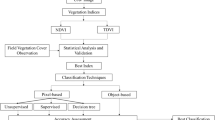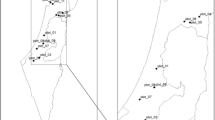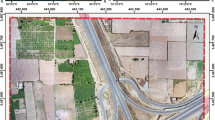Abstract
The Appalachian region of the United States has experienced significant growth in the production of natural gas. Developing the infrastructure required to transport this resource to market creates significant disturbances across the landscape, as both well pads and transportation pipelines must be created in this mountainous terrain. Midstream infrastructure, which includes pipeline rights-of-way and associated infrastructure, can cause significant environmental degradation, especially in the form of sedimentation. The introduction of this non-point source pollutant can be detrimental to freshwater ecosystems found throughout this region. This ecological risk has necessitated the enactment of regulations related to midstream infrastructure development. Weekly, inspectors travel afoot along new pipeline rights-of-way, monitoring the re-establishment of surface vegetation and identifying failing areas for future management. The topographically challenging terrain of West Virginia makes these inspections difficult and dangerous to the hiking inspectors. We evaluated the accuracy at which unmanned aerial vehicles replicated inspector classifications to evaluate their use as a complementary tool in the pipeline inspection process. Both RGB and multispectral sensor collections were performed, and a support vector machine classification model predicting vegetation cover were made for each dataset. Using inspector defined validation plots, our research found comparable high accuracy between the two collection sensors. This technique displays the capability of augmenting the current inspection process, though it is likely that the model can be improved further. The high accuracy thus obtained suggests valuable implementation of this widely available technology in aiding these challenging inspections.









Similar content being viewed by others
References
Alley-Young G (2020) Drone (Unmanned aerial vehicle). Salem Press Encyclopedia. Salem Press, Ipswich
Baldridge AM, Hook SJ, Grove CI, Rivera G (2009) The ASTER spectral library version 2.0. Remote Sens Environ 113:711–715. https://doi.org/10.1016/j.rse.2008.11.007
Campbell JB, Wynne RH (2011) Introduction to remote sensing, 5th edn. Guilford Press, New York
Carabassa V, Montero P, Crespo M, Padró JC, Pons X, Balagué J, Brotons L, Alcañiz JM (2020) Unmanned aerial system protocol for quarry restoration and mineral extraction monitoring. J Environ Manag 270:110717. https://doi.org/10.1016/j.jenvman.2020.110717
Cederholm CJ, Lestelle LC (1974) Observations on the effects of landslide siltation on salmon and trout resources of the Clearwater River, Jefferson County, WA, 1972-1973, Final Report. University of Washington, Seattle
Doman L, Kahan A (2018) United States remains the world’s top producer of petroleum and natural gas hydrocarbons. US Energy Information Administration, 21. https://www.eia.gov/todayinenergy/detail.php?id=36292. Accessed 12 Apr 2022
Esri (2021) ArcGIS Pro 2.9.2. Environmental Systems Research Institute, Redlands
Grushecky ST, Harris KJ, Strager MP, Wang J, Mesa AN (2022) Land cover change associated with unconventional oil and gas development in the appalachian region. Environ Manag 70:869–880. https://doi.org/10.1007/s00267-022-01702-y
Grybas H, Congalton RG (2021) A comparison of multi-temporal RGB and Multispectral UAS imagery for tree species classification in heterogeneous New Hampshire forests. Remote Sens 13:2631. https://doi.org/10.3390/rs13132631
Hallermann N, Morgenthal G (2014) Visual inspection strategies for large bridges using Unmanned Aerial Vehicles (UAV). In: Chen A, Frangopol D, Ruan X (eds) Bridge maintenance, safety, management and life extension: proceedings of the seventh International Conference of Bridge Maintenance, Safety and Management, Shanghai, July 2014. CRC Press, Boca Raton, pp 661–667
Kargbo DM, Wilhelm RG, Campbell DJ (2010) Natural gas plays in the Marcellus shale: challenges and potential opportunities. Environ Sci Technol 44:5679–5684. https://doi.org/10.1021/es903811p
Kemp P, Sear D, Collins A, Naden P, Jones I (2011) The impacts of fine sediment on riverine fish. Hydrol Process 25:1800–1821. https://doi.org/10.1002/hyp.7940
Kim J, Kim S, Ju C, Son HI (2019) Unmanned aerial vehicles in agriculture: a review of perspective of platform, control, and applications. IEEE Access 7:105100–105115. https://doi.org/10.1109/ACCESS.2019.2932119
Kokaly RF, Clark RN, Swayze GA, Livo KE, Hoefen TM, Pearson NC, Wise RA, Benzel WM, Lowers HA, Driscoll RL, Klein AJ (2017) USGS spectral library version 7. U S Geol Surv Data Ser 1035:61. https://doi.org/10.5066/F7RR1WDJ
Langlois LA, Drohan PJ, Brittingham MC (2017) Linear infrastructure drives habitat conversion and forest fragmentation associated with Marcellus shale gas development in a forested landscape. J Environ Manag 197:167–176. https://doi.org/10.1016/j.jenvman.2017.03.045
Liu P, Choo KKR, Wang L, Huang F (2017) SVM or deep learning? A comparative study on remote sensing image classification. Soft Comput 21:7053–7065. https://doi.org/10.1007/s00500-016-2247-2
Marcellus Drilling News (2021) SWPA olympus well becomes longest marcellus onshore lateral. Marcellus Drilling News. https://marcellusdrilling.com/2020/12/swpa-olympus-well-becomes-longest-marcellus-onshore-lateral/. Accessed 12 Jan 2022
Meerdink SK, Hook SJ, Roberts DA, Abbott EA (2019) The ECOSTRESS spectral library version 1.0. Remote Sens Environ 230:1–8. https://doi.org/10.1016/j.rse.2019.05.015
Messersmith D, Brockett D, Loveland C (2015) Understanding natural gas compressor stations. Penn State Extension. https://extension.psu.edu/understanding-natural-gas-compressor-stations. Accessed 5 Jan 2022
Natural Resources Conservation Service (2019) Web soil survey. http://websoilsurvey.sc.egov.usda.gov/. Accessed 14 Jan2022
Nikolic J, Burri M, Rehder J, Leutenegger S, Huerzeler C, Siegwart R (2013) A UAV system for inspection of industrial facilities. In: Proceeding of the 2013 IEEE aerospace conference, IEEE, Big Sky, 2 - 9 March 2013. https://doi.org/10.1109/AERO20459.2013
Olmstead SM, Muehlenbachs LA, Shih JS, Chu Z, Krupnick AJ (2013) Shale gas development impacts on surface water quality in Pennsylvania. PNAS 110:4962–4967. https://doi.org/10.1073/pnas.1213871110
Popova O (2017a) Marcellus shale play: geology review. U.S. Energy Information Administration. https://www.eia.gov/maps/pdf/MarcellusPlayUpdate_Jan2017.pdf. Accessed 3 Jan 2022
Popova O (2017b) Utica shale play: geology review. U.S. Energy Information Administration. https://www.eia.gov/maps/pdf/UticaShalePlayReport_April2017.pdf. Accessed 3 Jan 2022
Richards C, Bacon KL (1994) Influence of fine sediment on macroinvertebrate colonization of surface and hyporheic stream substrates. Gt Basin Nat 54:106–113. http://www.jstor.org/stable/41712819
Sabat-Tomala A, Raczko E, Zagajewski B (2020) Comparison of support vector machine and random forest algorithms for invasive and expansive species classification using airborne hyperspectral data. Remote Sens 12:516. https://doi.org/10.3390/rs12030516
Sheykhmousa M, Mahdianpari M, Ghanbari H, Mohammadimanesh F, Ghamisi P, Homayouni S (2020) Support vector machine versus random forest for remote sensing image classification: a meta-analysis and systematic review. IEEE J Sel Top Appl Earth Obs Remote Sens 13:6308–6325. https://doi.org/10.1109/JSTARS.2020.3026724
Tucker CJ (1979) Red and photographic infrared linear combinations for monitoring vegetation. Remote Sens Environ 8:127–150
U.S. Department of Energy. 2020. The appalachian energy and petrochemical renaissance: an examination of economic progress and opportunities. https://www.energy.gov/sites/prod/files/2020/06/f76/Appalachian%20Energy%20and%20Petrochemical%20Report_063020_v3.pdf. Accessed 3 Jan 2022
U.S. Energy Information Administration (2021). Natural gas explained. https://www.eia.gov/energyexplained/natural-gas/. Accessed 03 Jan 2022
Warner N, Christie C, Jackson RB, Vengosh A (2013) Impacts of shale gas wastewater disposal on water quality in western Pennsylvania. Environ Sci Technol 47:11849–11857. https://doi.org/10.1021/es402165b
West Virginia Department of Environmental Protection (2013) General water pollution control permit. https://dep.wv.gov/WWE/Programs/stormwater/csw/Documents/OG%20stormwater%20GP%203_10_15.pdf. Accessed 12 Apr 2022
West Virginia Department of Environmental Protection (2016) Erosion and sediment control best management practice manual. https://dep.wv.gov/WWE/Programs/stormwater/csw/Documents/E%20and%20S_BMP_2006.pdf. Accessed 12 Apr 2022
Zeng Y, Feng Z, Xiang N (2004) Assessment of soil moisture using Landsat ETM+ temperature/vegetation index in semiarid environment. IGARSS 2004 IEEE Int Geosci Remote Sens Symp 6:4306–4309. https://doi.org/10.1109/IGARSS.2004.1370089
Zheng H, Zhou X, He J, Yao X, Cheng T, Zhu Y, Cao W, Tian Y (2020) Early season detection of rice plants using RGB, NIR-G-B and multispectral images from unmanned aerial vehicle (UAV). Comput Electron Agric 169:105223. https://doi.org/10.1016/j.compag.2020.105223
Acknowledgements
Special acknowledgment to Sam Bearinger and Lucas Kinder of the WVU Natural Resource Analysis Center who helped to fly and process the UAV imagery. This project was supported by funding from the United States Department of Transportation Pipeline and Hazardous Materials Safety Administration. And lastly, this work was also supported by the National Institute of Food and Agriculture, McIntire Stennis project 1015672, and the West Virginia Agricultural and Forestry Experiment Station.
Author Contributions
ANM collected and analyzed the data, and wrote the manuscript. MPS, STG and PK provided guidance for the experiment design and analysis, and provided edits for the manuscript. All authors reviewed the manuscript.
Funding
The research leading to these results received funding from the United States Department of Transportation Pipeline and Hazardous Materials Safety Administration under Grant Agreement No. 693JK31950007CAAP, and the United States Department of Agriculture National Institute of Food and Agriculture, Hatch under ascension number 7004979, and scientific article No: 3459 of the West Virginia Agricultural and Forestry Experiment Station, Morgantown.
Author information
Authors and Affiliations
Corresponding author
Ethics declarations
Conflict of Interest
The authors declare no competing interests.
Additional information
Publisher’s note Springer Nature remains neutral with regard to jurisdictional claims in published maps and institutional affiliations.
Rights and permissions
Springer Nature or its licensor (e.g. a society or other partner) holds exclusive rights to this article under a publishing agreement with the author(s) or other rightsholder(s); author self-archiving of the accepted manuscript version of this article is solely governed by the terms of such publishing agreement and applicable law.
About this article
Cite this article
Mesa, A.N., Strager, M.P., Grushecky, S.T. et al. Using Unmanned Aerial Vehicles to Evaluate Revegetation Success on Natural Gas Pipelines. Environmental Management 72, 671–681 (2023). https://doi.org/10.1007/s00267-023-01842-9
Received:
Accepted:
Published:
Issue Date:
DOI: https://doi.org/10.1007/s00267-023-01842-9




